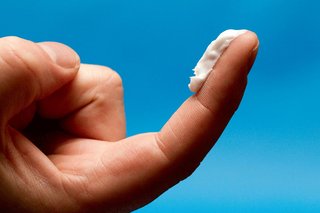Always follow the instructions from your pharmacist or doctor or the leaflet in the medicine packet.
Dosage and strength
Clobetasone comes in a strength of 0.05%, and contains 5mg of clobetasone butyrate in each 10g of cream and ointment.
Most people only need to use clobetasone 1 or 2 times a day for a week. If your doctor has prescribed it, they may suggest that you use it for longer than a week.
How to use it
If you use clobetasone 2 times a day, try to leave a gap of 8 to 12 hours between each use.
How to apply cream or ointment
Clobetasone cream is better for skin that is moist or weepy. Ointment is thicker and greasier and is better for dry or flaky areas of skin.
Sometimes, the amount of cream or ointment you need to use is measured in fingertip units. This is the amount of cream or ointment you can squeeze onto your fingertip.
A fingertip unit of cream should be enough to treat an area of skin that is double the size of the palm of your hand.
For babies and children, the right amount of cream depends on their age. Your doctor or pharmacist can advise you.

- Wash and dry your hands and then squeeze out the right amount.
- Spread the cream or ointment in a thin layer over the area of irritated skin.
- Carefully smooth it into your skin in the direction that your hair grows until it disappears.
- Use the cream or ointment on all the irritated skin, not just the worst areas.
- Be careful not to get it into broken skin or cuts.
- Wash your hands afterwards (unless it's your hands that you're treating).
Do not use clobetasone at the same time as other creams or ointments such as a moisturiser. Wait at least 30 minutes between using clobetasone and any other product.
If you need to use a dressing like a bandage or plaster, wait at least 10 minutes after putting clobetasone on.
When using clobetasone on babies with nappy rash, do not put the nappy on straight away. This helps to prevent side effects from the clobetasone.
Important: Fire warning
Skin creams and ointments can dry onto your clothes and bedding. This makes them more likely to catch fire. Avoid naked flames.
How long to use it for
How long you use clobetasone for depends on why you're using it.
For insect bites and stings, nappy rash or contact dermatitis you'll probably only need to use clobetasone for up to a week.
For long-term skin problems such as eczema and psoriasis, you may need to use clobetasone for longer under the supervision of your doctor.
If you have been using clobetasone on your child (12 years and under) for 7 days with no improvement, speak to their doctor.
To reduce the risk of side effects, your doctor may recommend using clobetasone for only a few weeks at a time. Once your skin is better, use moisturisers to help stop skin inflammation from coming back.
Your doctor may recommend using clobetasone in between courses of stronger steroids. This is known as maintenance therapy and can keep your condition under control and reduce the risk of side effects.
If you've been using clobetasone for a long time you may need to slowly reduce the amount you use and how often you use it before stopping completely. This helps to stop your symptoms from coming back.
Talk to you doctor if you want to stop treatment after using clobetasone for a long time.
If you forget to use it
If you forget to use either the cream or ointment, use it as soon as you remember, unless it's within a few hours of your next dose. In this case, skip the missed dose and go back to your normal routine.
If you use it twice a day, try to leave a gap of 8 to 12 hours in between.
Stopping clobetasone
Talk to your doctor before stopping treatment if you've been using clobetasone for a long time. They may tell you to gradually use less of it, and use it less often, before you stop completely. This reduces the chance of your symptoms coming back.
Using clobetasone for a long time can increase the risk of having a withdrawal reaction when you stop using it. You might have a burning feeling and redness, although this may be more difficult to see on brown or black skin.
The reaction will feel different to the skin condition you've been using clobetasone for. It may cover a larger area than the area you were treating.
Important
If you get a withdrawal reaction or your condition comes back within 2 weeks of stopping clobetasone, do not start using it again without checking with your doctor.